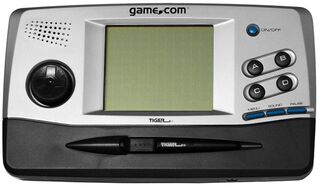Difference between revisions of "Game.com"
From Sega Retro
m (Text replacement - "logos=\[\[File:(.*).png.*" to "| logo=$1.png") |
m (Text replacement - "Category:Non-Sega consoles" to "{{NonSegaConsoles}}") |
||
| Line 20: | Line 20: | ||
Despite its limited success many big publishers backed the console during its early years, including [[Sega]]. Only two Sega games were released for the handheld, both of which were watered-down "ports" of [[Sega Saturn]] games - ''[[sonic:Sonic Jam (Game.com)|Sonic Jam]]'' and ''[[Fighters Megamix (Game.com)|Fighters Megamix]]''. ''Sonic Jam'' stands as the first ''Sonic the Hedgehog'' game to be released on a non-Sega console. | Despite its limited success many big publishers backed the console during its early years, including [[Sega]]. Only two Sega games were released for the handheld, both of which were watered-down "ports" of [[Sega Saturn]] games - ''[[sonic:Sonic Jam (Game.com)|Sonic Jam]]'' and ''[[Fighters Megamix (Game.com)|Fighters Megamix]]''. ''Sonic Jam'' stands as the first ''Sonic the Hedgehog'' game to be released on a non-Sega console. | ||
| − | + | {{NonSegaConsoles}} | |
Revision as of 14:34, 2 October 2020

| |||||||||

| |||||||||
| Game.com | |||||||||
|---|---|---|---|---|---|---|---|---|---|
| Manufacturer: Tiger Electronics | |||||||||
|
This short article is in need of work. You can help Sega Retro by adding to it.
The Game.com (pronounced "game com") was a short-lived cartridge-based handheld video game system by Tiger Electronics originally released in late 1997. Though not the first to be developed by the company (this title goes to the Tiger R-Zone), the Game.com is perhaps its most memorable foray into the market.
Despite an aggressive marketing strategy the handheld system was largely ignored by the gaming press at the time, and under-performed significantly, leading to it being pulled in the space of two years. It is a heavily criticised console, which despite being released eight years after its main rival, the Nintendo Game Boy, offers few advantages and in many areas performs worse.
Critics have highlighted the Game.com's poor screen, audio capabilities and software library, consisting of poorly programmed games, many of which fail to maintain a constant framerate. The Game.com was largely exclusive to the US market and was the first to offer limited internet capabilities. It also contains two cartridge slots and a resistive touch screen, plus various pieces of built-in software such as calendars and calculators.
Despite its limited success many big publishers backed the console during its early years, including Sega. Only two Sega games were released for the handheld, both of which were watered-down "ports" of Sega Saturn games - Sonic Jam and Fighters Megamix. Sonic Jam stands as the first Sonic the Hedgehog game to be released on a non-Sega console.
| Non-Sega consoles |
|---|
| Nintendo |
| Nintendo Entertainment System (1983) | Game Boy (1989) | Super Nintendo Entertainment System (1990) | Nintendo 64 (1996) | Game Boy Color (1998) | Game Boy Advance (2001) | Nintendo GameCube (2001) | Nintendo DS (2004) | Wii (2006) | Nintendo 3DS (2011) | Wii U (2012) | Nintendo Switch (2017) |
| Sony |
| PlayStation (1994) | PlayStation 2 (2000) | PlayStation Portable (2004) | PlayStation 3 (2006) | PlayStation Vita (2011) | PlayStation 4 (2013) | PlayStation 5 (2020) |
| Microsoft |
| Xbox (2001) | Xbox 360 (2005) | Xbox One (2013) | Xbox Series X (2020) |
| Mobile |
| iOS | Android | Windows Phone |
| Other |
| Atari 2600 (1977) | ColecoVision (1982) | PC Engine (1987) | R-Zone (1995) | Game.com (1997) | WonderSwan (1998) | Neo Geo Pocket Color (1999) | N-Gage (2003) | LeapFrog Didj (2008) | Stadia (2019) |